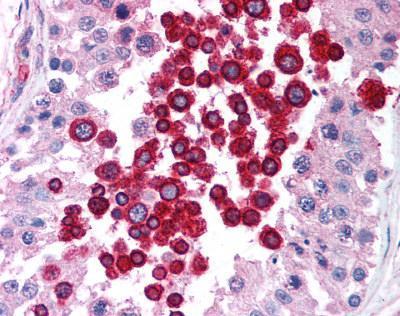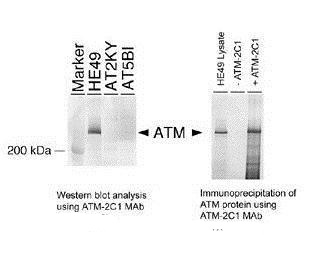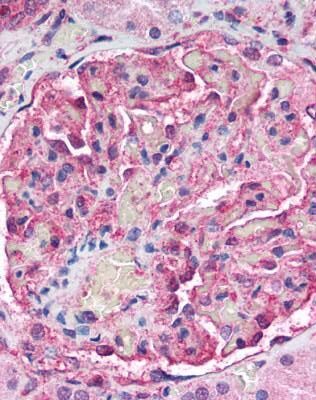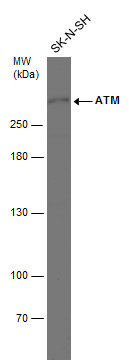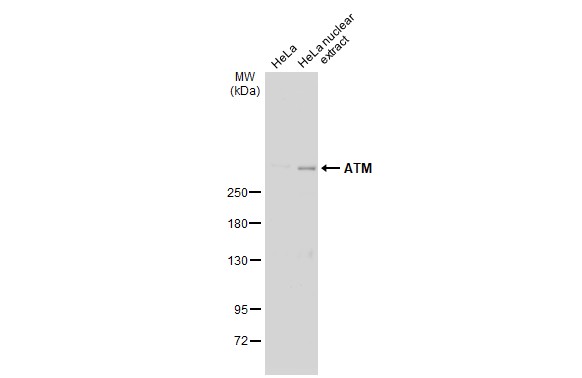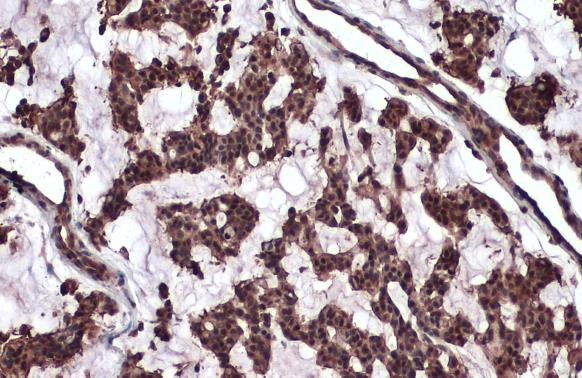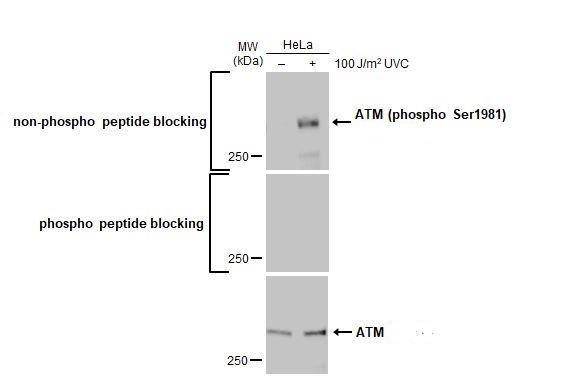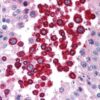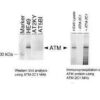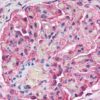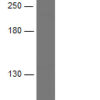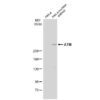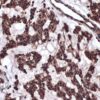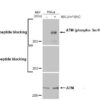Anti-ATM Antibody (3310)
$503.00
| Host | Quantity | Applications | Species Reactivity | Data Sheet | |
|---|---|---|---|---|---|
| Mouse | 100ug | WB,ICC/IF,IHC-P,FACS,IP,ELISA,ChIP,IHC | Human, Mouse, Rat, Monkey |  |
SKU: 3310
Categories: Antibody Products, Cancer Research Antibodies, Products
Overview
Product Name Anti-ATM Antibody (3310)
Description Anti-ATM Mouse Monoclonal Antibody
Target ATM
Species Reactivity Human, Mouse, Rat, Monkey
Applications WB,ICC/IF,IHC-P,FACS,IP,ELISA,ChIP,IHC
Host Mouse
Clonality Monoclonal
Clone ID 2C1
Isotype IgG1
Immunogen GST fusion protein expressed in E. coli corresponding to aa 2577- 3056 of full-length ATM.
Properties
Form Liquid
Concentration Lot Specific
Formulation PBS, pH 7.4
Buffer Formulation Phosphate Buffered Saline
Buffer pH pH 7.4
Format Purified
Purification Purified by Protein G affinity chromatography
Specificity Information
Specificity This antibody recognizes full-length ATM, a 370 kD nuclear phosphoprotein, which is involved in the autooal recessive disease ataxia telangiectasia (AT). ATM belongs to a novel family of proteins associated with cell cycle regulation and response to DNA repair. The C-terminal region has extensive homology to the catalytic domains of phosphatidylinositol 3-kinases (PI3 kinases). Its usefulness to monitor altered ATM expression in cancer is under active investigations.
Target Name Serine-protein kinase ATM
Target ID ATM
Uniprot ID Q13315
Alternative Names EC 2.7.11.1, Ataxia telangiectasia mutated, A-T mutated
Gene Name ATM
Gene ID 472
Accession Number NP_000042
Sequence Location Nucleus, Cytoplasmic vesicle, Cytoplasm, cytoskeleton, microtubule organizing center, centrosome
Biological Function Serine/threonine protein kinase which activates checkpoint signaling upon double strand breaks (DSBs), apoptosis and genotoxic stresses such as ionizing ultraviolet A light (UVA), thereby acting as a DNA damage sensor. RPubMed:10550055, PubMed:10766245, PubMed:10802669, PubMed:10839545, PubMed:10910365, PubMed:10973490, PubMed:11375976, PubMed:12086603, PubMed:12556884, PubMed:14871926, PubMed:15448695, PubMed:15456891, PubMed:15916964, PubMed:16086026, PubMed:16858402, PubMed:17923702, PubMed:19431188, PubMed:19965871, PubMed:26774286, PubMed:29203878, PubMed:30612738, PubMed:30886146, PubMed:9733514, PubMed:9733515, PubMed:9843217}.
Research Areas Cancer Research
Application Images








Description Human Testis (formalin-fixed, paraffin-embedded) stained with ATM antibody at 5 ug/ml followed by biotinylated anti-mouse IgG secondary antibody, alkaline phosphatase-streptavidin and chromogen.

Description Detection of human ATM protein using anti-ATM 2C1 monoclonal antibody (3310) by western blot or immunoprecipitation.

Description Human Kidney (formalin-fixed, paraffin-embedded) stained with ATM antibody at 5 ug/ml followed by biotinylated anti-mouse IgG secondary antibody, alkaline phosphatase-streptavidin and chromogen.

Description Whole cell extract (30 ug) was separated by 5% SDS-PAGE, and the membrane was blotted with ATM antibody [2C1] (3310) diluted at 1:1000.

Description HeLa whole cell extract and nuclear extracts (30 ug) were separated by 5% SDS-PAGE, and the membrane was blotted with ATM antibody [2C1] (3310) diluted at 1:500. The HRP-conjugated anti-mouse IgG antibody was used to detect the primary antibody.

Description ATM antibody [2C1] detects ATM protein at nucleus by immunohistochemical analysis.Sample: Paraffin-embedded human breast carcinoma.ATM stained by ATM antibody [2C1] (3310) diluted at 1:100.Antigen Retrieval: Citrate buffer, pH 6.0, 15 min

Description Untreated (–) and treated (+) 293T whole cell extracts (60 ug) were separated by 5% SDS-PAGE, and the membrane was blotted with ATM antibody [2C1] (3310) diluted at 1:1000. The HRP-conjugated anti-mouse IgG antibody was used to detect the primary antibody, and the signal was developed with Trident ECL plus-Enhanced.
Handling
Storage This antibody is stable for at least one (1) year at -70°C. Avoid multiple freeze-thaw cycles.
Dilution Instructions Dilute in PBS or medium which is identical to that used in the assay system.
Application Instructions Immunoblotting: use at 1-10 ug/mL.
Immunoprecipitation: use at 1-10 ug/mL.
Positive controls: Raji or Akata cells.
Immunoprecipitation: use at 1-10 ug/mL.
Positive controls: Raji or Akata cells.
References & Data Sheet
References Chen, G and EY-HP Lee (1996) J Biol Chem 271: 33693-33697.
PMID 8969240
Data Sheet  Download PDF Data Sheet
Download PDF Data Sheet
 Download PDF Data Sheet
Download PDF Data Sheet

